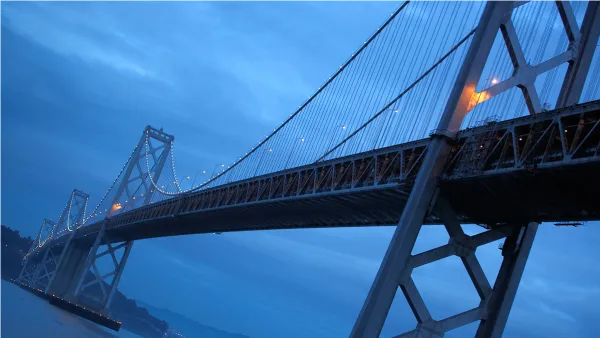A new law hopes to expunge the "impulse and accessibility" aspect of suicides from new or rebuilt bridges by requiring that they "consider" suicide barriers. The price for barriers can be greatly reduced when evaluated in the planning phase.
AB 755 "moves the state to begin evaluating the need for such barriers or other prevention efforts on new bridges", stated the author, Assemblyman Tom Ammiano (D-San Francisco) in his press release. He had served 12 years on the Golden Gate Bridge & Transportation District. While the Golden Gate Bridge, where "more than 1,600 people have jumped and fallen 200-plus feet into the bay", has not approved a barrier but a stainless steel net in 2008, it has yet to allocate the $40 million to $50 million to fund it, writes Melody Gutierrez.
Those who advocate suicide barriers on California's bridges say the jump is about impulse and accessibility. Stopping someone from jumping the first time is often enough, whether it's from the Foresthill Bridge [in Placer County, where Gutierrez wrote the story], which is the fourth-highest bridge in the United States [and the highest in California at 730 feet above the American River], or the Golden Gate Bridge, where more people have committed suicide than anywhere else in the world.
Barrier advocates "point to a 1978 study by Richard Seiden of UC Berkeley, who tracked 515 people who were prevented from jumping off the Golden Gate Bridge between 1937 and 1971. Seiden's research found that only 6 percent went on to commit suicide after their failed attempt." [This study is also cited in our 2008 post on this topic, "If You Prevent It, They Won't Do It".]
A key group behind the new law is the Bridge Rail Foundation, which "has has one simple goal - stop the suicides on the Golden Gate Bridge."
With the emphasis on preventing bridge suicides, it was surprising to some that the new eastern span of the Bay Bridge, which opened Sept. 2, lacks such a barrier.
A jump from the new Bay Bridge probably won't kill anyone because it's not high enough. That's the explanation Ammiano said he was given when he asked state officials whether suicide barriers had been considered during construction of the $6.3 billion eastern span.
After considerable opposition from groups representing local city and county governments, the bill was amended to state that "the new law would be satisfied by including a document in project study reports that show a suicide barrier was considered during the construction of a new bridge or replacement of one with a history of suicides," writes Gutierrez.
FULL STORY: Suicide barriers back in spotlight with Calif. law

Analysis: Cybertruck Fatality Rate Far Exceeds That of Ford Pinto
The Tesla Cybertruck was recalled seven times last year.

National Parks Layoffs Will Cause Communities to Lose Billions
Thousands of essential park workers were laid off this week, just before the busy spring break season.

Retro-silient?: America’s First “Eco-burb,” The Woodlands Turns 50
A master-planned community north of Houston offers lessons on green infrastructure and resilient design, but falls short of its founder’s lofty affordability and walkability goals.

Test News Post 1
This is a summary

Analysis: Cybertruck Fatality Rate Far Exceeds That of Ford Pinto
The Tesla Cybertruck was recalled seven times last year.

Test News Headline 46
Test for the image on the front page.
Urban Design for Planners 1: Software Tools
This six-course series explores essential urban design concepts using open source software and equips planners with the tools they need to participate fully in the urban design process.
Planning for Universal Design
Learn the tools for implementing Universal Design in planning regulations.
EMC Planning Group, Inc.
Planetizen
Planetizen
Mpact (formerly Rail~Volution)
Great Falls Development Authority, Inc.
HUDs Office of Policy Development and Research
NYU Wagner Graduate School of Public Service


























